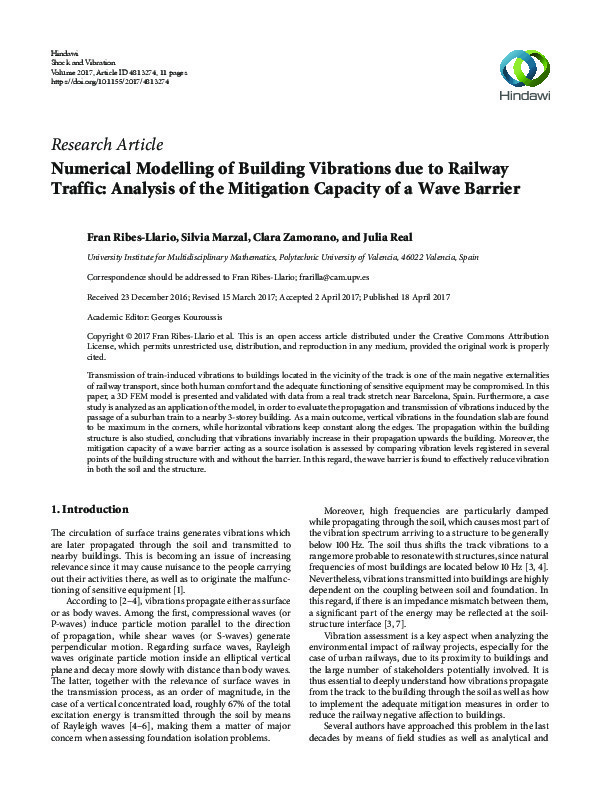JavaScript is disabled for your browser. Some features of this site may not work without it.
Buscar en RiuNet
Listar
Mi cuenta
Estadísticas
Ayuda RiuNet
Admin. UPV
Numerical Modelling of Building Vibrations due to Railway Traffic: Analysis of the Mitigation Capacity of a Wave Barrier
Mostrar el registro sencillo del ítem
Ficheros en el ítem
| dc.contributor.author | Ribes-Llario, Fran
|
es_ES |
| dc.contributor.author | Marzal-Romeu, Silvia
|
es_ES |
| dc.contributor.author | Zamorano-Martín, Clara
|
es_ES |
| dc.contributor.author | Real Herráiz, Julia Irene
|
es_ES |
| dc.date.accessioned | 2018-07-16T06:41:17Z | |
| dc.date.available | 2018-07-16T06:41:17Z | |
| dc.date.issued | 2017 | es_ES |
| dc.identifier.issn | 1070-9622 | es_ES |
| dc.identifier.uri | http://hdl.handle.net/10251/105803 | |
| dc.description.abstract | [EN] Transmission of train-induced vibrations to buildings located in the vicinity of the track is one of the main negative externalities of railway transport, since both human comfort and the adequate functioning of sensitive equipment may be compromised. In this paper, a 3D FEM model is presented and validated with data from a real track stretch near Barcelona, Spain. Furthermore, a case study is analyzed as an application of themodel, in order to evaluate the propagation and transmission of vibrations induced by the passage of a suburban train to a nearby 3-storey building. As a main outcome, vertical vibrations in the foundation slab are found to be maximum in the corners, while horizontal vibrations keep constant along the edges. The propagation within the building structure is also studied, concluding that vibrations invariably increase in their propagation upwards the building. Moreover, the mitigation capacity of a wave barrier acting as a source isolation is assessed by comparing vibration levels registered in several points of the building structure with and without the barrier. In this regard, the wave barrier is found to effectively reduce vibration in both the soil and the structure. | es_ES |
| dc.language | Inglés | es_ES |
| dc.publisher | Hindawi Limited | es_ES |
| dc.relation.ispartof | Shock and Vibration | es_ES |
| dc.rights | Reconocimiento (by) | es_ES |
| dc.subject.classification | INGENIERIA E INFRAESTRUCTURA DE LOS TRANSPORTES | es_ES |
| dc.subject.classification | TECNOLOGIA ELECTRONICA | es_ES |
| dc.title | Numerical Modelling of Building Vibrations due to Railway Traffic: Analysis of the Mitigation Capacity of a Wave Barrier | es_ES |
| dc.type | Artículo | es_ES |
| dc.identifier.doi | 10.1155/2017/4813274 | es_ES |
| dc.rights.accessRights | Abierto | es_ES |
| dc.contributor.affiliation | Universitat Politècnica de València. Instituto Universitario de Matemática Multidisciplinar - Institut Universitari de Matemàtica Multidisciplinària | es_ES |
| dc.contributor.affiliation | Universitat Politècnica de València. Departamento de Ingeniería Electrónica - Departament d'Enginyeria Electrònica | es_ES |
| dc.contributor.affiliation | Universitat Politècnica de València. Departamento de Ingeniería e Infraestructura de los Transportes - Departament d'Enginyeria i Infraestructura dels Transports | es_ES |
| dc.description.bibliographicCitation | Ribes-Llario, F.; Marzal-Romeu, S.; Zamorano-Martín, C.; Real Herráiz, JI. (2017). Numerical Modelling of Building Vibrations due to Railway Traffic: Analysis of the Mitigation Capacity of a Wave Barrier. Shock and Vibration. 1-11. doi:10.1155/2017/4813274 | es_ES |
| dc.description.accrualMethod | S | es_ES |
| dc.relation.publisherversion | http://doi.org/10.1155/2017/4813274 | es_ES |
| dc.description.upvformatpinicio | 1 | es_ES |
| dc.description.upvformatpfin | 11 | es_ES |
| dc.type.version | info:eu-repo/semantics/publishedVersion | es_ES |
| dc.relation.pasarela | S\358434 | es_ES |








